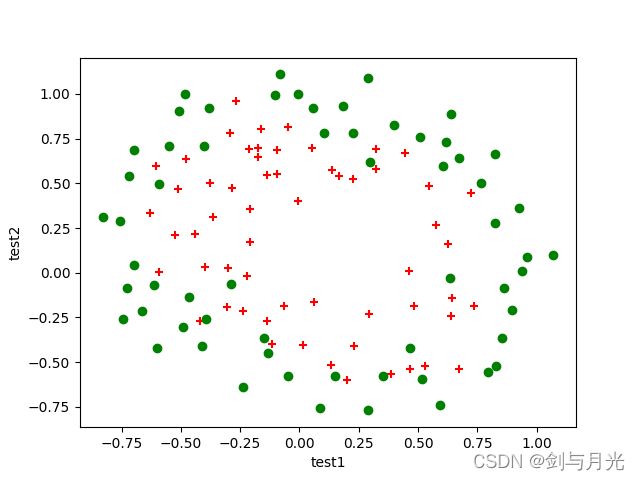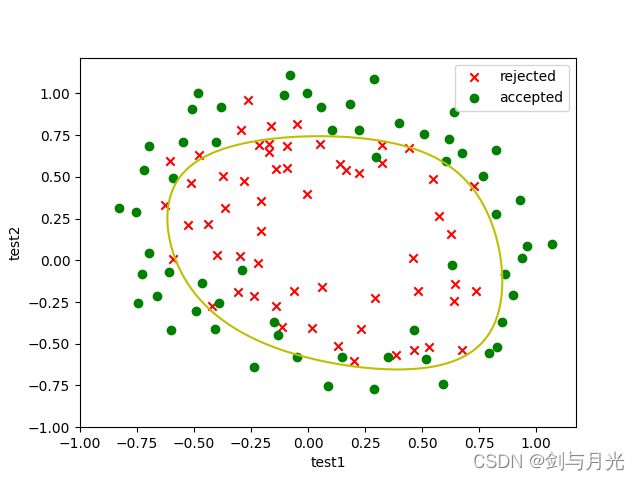吴恩达机器学习 逻辑回归 作业2(Python实现)
题目
在本部分的练习中,您将使用正则化的Logistic回归模型来预测一个制造工厂的微芯片是否通过质量保证(QA),在QA过程中,每个芯片都会经过各种测试来保证它可以正常运行。假设你是这个工厂的产品经理,你拥有一些芯片在两个不同测试下的测试结果,从这两个测试,你希望确定这些芯片是被接受还是拒绝,为了帮助你做这个决定,你有一些以前芯片的测试结果数据集,从中你可以建一个Logistic回归模型。
目录
1 正则化逻辑回归函数
2 思路
3 完整代码
1 正则化逻辑回归函数
正则化逻辑回归中,代价函数和梯度函数均有所改变:
2 思路
注:这部分简述了我的思考过程,代码有不完善之处,也存在部分重复,相比完整版代码有所增删。
首先读入数据,画出散点图以确定使用曲线阶数。
path=' ' #文件路径
data=pd.read_csv(path,delimiter=',',names=['test1','test2','result'])
'''绘制散点图的函数'''
def plot_data(data):
pos_data=data[data.result==1]
neg_data=data[data.result==0]
plt.scatter(pos_data.test1,pos_data.test2,c='r',marker='+',label='rejected')
plt.scatter(neg_data.test1,neg_data.test2,c='g',marker='o',label='accepted')
plt.xlabel('test1')
plt.ylabel('test2')
plt.figure('raw data')
plot_data(data)
plt.show()发现数据点分布杂乱,因此需要进行特征映射以使用高阶曲线。本文后续将采用6阶曲线进行分类。先写出特征映射函数及其对应的求值函数:
def map_feature(x,y,power):
result=pd.DataFrame(np.ones(x.size),columns=['bias'])
for i in range(1,power+1):
for j in range(i+1):
temp=x**j*y**(i-j)
result=pd.concat([result,temp],axis=1)
return result
def feature_cal(x1,x2,power,theta):
res=0
pr=0
for i in range(power+1):
for j in range(i+1):
res+=x1**j*x2**(i-j)*theta[pr]
pr+=1
return res然后根据公式,实现逻辑回归需要使用的三个主要函数:
def sigmoid(x):
return 1/(1+np.exp(-x))
def cost_function1(theta,x,y):
size=y.size
return -1/size*([email protected](sigmoid(x@theta))+(1-y)@np.log(1-sigmoid(x@theta)))
def cost_function2(theta,x,y,lbd=1):
size=y.size
theta_p=theta[1:]
return cost_function1(theta,x,y)+lbd/(2*size)*np.sum(theta_p*theta_p)
def gradient1(theta,x,y):
size=y.size
return 1/size*(sigmoid(x@theta)-y).T@x
def gradient2(theta,x,y,lbd=1):
theta_p=theta/y.size
theta_p[0]=0
return gradient1(theta,x,y)+theta_p 然后就可以处理数值以求解data。求解![]() 极值时调用了scipy.optimize库提供的拟牛顿迭代算法bfgs&l_bfgs:
极值时调用了scipy.optimize库提供的拟牛顿迭代算法bfgs&l_bfgs:
path='D:\机器学习\dataset\ex2data2.txt'
data=pd.read_csv(path,delimiter=',',names=['test1','test2','result'])
x1=data['test1']
x2=data['test2']
x=map_feature(x1,x2,6)
y=data['result']
x=x.values
y=y.values
theta=np.zeros(x.shape[1])
'''任选迭代方法'''
# theta1=opt.fmin_bfgs(f=cost_function2,fprime=gradient2,x0=theta,args=(x,y),maxiter=400)
theta1,cost,*u=opt.fmin_l_bfgs_b(func=cost_function2,fprime=gradient2,x0=theta,args=(x,y),maxiter=400)最后使用plt.contour方法画出决策边界:
x_axis=np.linspace(-1,1,100)
y_axis=np.linspace(-1,1,100)
zz=np.zeros((x_axis.size,y_axis.size))
for xs in range(x_axis.size):
for ys in range(y_axis.size):
zz[xs,ys]=feature_cal(x_axis[xs],y_axis[ys],6,theta1)
plt.figure('boundary')
plot_data(data)
plt.contour(x_axis,y_axis,zz,0,colors='y')
# a=float(input())
# b=float(input())
# c=feature_cal(a,b,6,theta1)
# print(c)
# if c>0:
# plt.scatter(a,b,c='r',marker='2')
# else:
# plt.scatter(a,b,c='y',marker='1')
plt.show() 最后需要对拟合结果进行评估,进行学习率的调整。最后发现学习率 ![]() 就是不错的状态。
就是不错的状态。
3 完整代码
import numpy as np
import pandas as pd
import matplotlib.pyplot as plt
import scipy.optimize as opt
'''根据data画散点图'''
def plot_data(data):
pos_data=data[data.result==1]
neg_data=data[data.result==0]
plt.scatter(pos_data.test1,pos_data.test2,c='r',marker='x',label='rejected')
plt.scatter(neg_data.test1,neg_data.test2,c='g',marker='o',label='accepted')
plt.xlabel('test1')
plt.ylabel('test2')
'''特征映射'''
def map_feature(x,y,power):
result=pd.DataFrame(np.ones(x.size),columns=['bias'])
for i in range(1,power+1):
for j in range(i+1):
temp=x**j*y**(i-j)
result=pd.concat([result,temp],axis=1)
return result
'''计算特征映射后假设函数的值'''
def feature_cal(x1,x2,power,theta):
res=0
pr=0
for i in range(power+1):
for j in range(i+1):
res+=x1**j*x2**(i-j)*theta[pr]
pr+=1
return res
'''激活函数'''
def sigmoid(x):
return 1/(1+np.exp(-x))
'''原始代价函数'''
def cost_function1(theta,x,y):
size=y.size
return -1/size*([email protected](sigmoid(x@theta))+(1-y)@np.log(1-sigmoid(x@theta)))
'''正则化代价函数'''
def cost_function2(theta,x,y,lbd=1):
size=y.size
theta_p=theta[1:]
return cost_function1(theta,x,y)+lbd/(2*size)*np.sum(theta_p*theta_p)
'''原始梯度'''
def gradient1(theta,x,y):
size=y.size
return 1/size*(sigmoid(x@theta)-y).T@x
'''正则化梯度'''
def gradient2(theta,x,y,lbd=1):
theta_p=lbd*theta/y.size
theta_p[0]=0
return gradient1(theta,x,y)+theta_p
path='D:\机器学习\dataset\ex2data2.txt'
data=pd.read_csv(path,delimiter=',',names=['test1','test2','result'])
# plt.figure('raw data')
# plot_data(data)
# plt.legend()
# plt.show()
x1=data['test1']
x2=data['test2']
x=map_feature(x1,x2,6)
y=data['result']
x=x.values #将dataFrame转为ndarray
y=y.values
theta=np.zeros(x.shape[1])
lbd=1 #学习率,可调整
'''选用合适的方式梯度下降'''
# theta1=opt.fmin_bfgs(f=cost_function2,fprime=gradient2,x0=theta,args=(x,y),maxiter=400)
theta1,cost,*u=opt.fmin_l_bfgs_b(func=cost_function2,fprime=gradient2,x0=theta,args=(x,y,lbd),maxiter=400)
'''画出决策边界'''
x_axis=np.linspace(-1,1,100)
y_axis=np.linspace(-1,1,100)
zz=np.zeros((x_axis.size,y_axis.size))
for xs in range(x_axis.size):
for ys in range(y_axis.size):
zz[xs,ys]=feature_cal(x_axis[xs],y_axis[ys],6,theta1)
plt.figure('decision_boundary')
plot_data(data)
plt.contour(x_axis,y_axis,zz,0,colors='y',label='boundary') #函数值为0代表决策边界
plt.legend()
plt.show()
'''输出查准率'''
cnt=0
for i in range(x1.size):
val=feature_cal(x1[i],x2[i],6,theta1)
if (val>=0 and y[i]==1) or (val<=0 and y[i]==0):
cnt+=1
print('查准率: ',cnt/x1.size)
